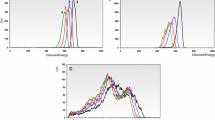Abstract
Liquid Scintillation Counting (LSC) gross alpha/beta screening is a valuable tool for providing rapid laboratory response for the analysis of human clinical urine samples during a large-scale radiation incident event. Verification of method performance, as required for clinical laboratory testing, is accomplished by the evaluation of routine, periodic measurements of radioactive spiked samples for quality control, performance testing, and accuracy checks. Radionuclide stability of alpha and beta emitters in urine for LSC analysis is an important consideration. The purpose of this work is to demonstrate optimal preparations and storage conditions of samples used for method verification.
Similar content being viewed by others
References
Saetun P, Semangoen T, Thongboonkerd V (2009) Characterizations of urinary sediments precipitated after freezing and their effects on urinary protein and chemical analyses. Am J Physiol Renal Physiol 296(6):1346–1354. https://doi.org/10.1152/ajprenal.90736.2008
Ercan M, Akbulut ED, Abuşoğlu S, Yılmaz FM, Oğuz EF, Topçuoğlu C, Öztekin V, Boğdaycıoğlu N (2015) Stability of urine specimens stored with and without preservatives at room temperature and on ice prior to urinalysis. Clin Biochem 48(13–14):919–922. https://doi.org/10.1016/j.clinbiochem.2015.05.016
Rotter M, Brandmaier S, Prehn C, Adam J, Rabstein S, Gawrych K, Brüning T, Illig T, Lickert H, Adamski J, Wang-Sattler R (2016) Stability of targeted metabolite profiles of urine samples under different storage conditions. Metabolomics 13(1):4. https://doi.org/10.1007/s11306-016-1137-z
Chang C, Obeid W, Thiessen-Philbrook H, Parikh CR (2021) Sample processing and stability for urine biomarker studies. J Appl Lab Med 6(6):1628–1634. https://doi.org/10.1093/jalm/jfab082
Bornhorst JA, Hunt JW, Urry FM, McMillin GA (2005) Comparison of sample preparation method for clinical trace element analysis by inductively coupled plasma mass spectrometry. Am J Clin Pathol 123:579–583. https://doi.org/10.1309/L241-WUER-8831-GLWB
Burden TJ, Whitehead MW, Thompson RPH, Powell JJ (1998) Preparation of urine samples for trace metal determination: a study with aluminum analysis by inductively coupled plasma optical emission spectrometry. Ann Clin Biochem 35:245–253. https://doi.org/10.1177/000456329803500208
Piraner O, Jones R (2021) Urine gross alpha/beta bioassay method development using liquid scintillation counting techniques. J Radioanal Nucl Chem 327(1):513–523. https://doi.org/10.1007/s10967-020-07493-y
Piraner O, Jones R (2009) Urine gross alpha/beta analysis by liquid scintillation counting for emergency and terrorism preparedness and response. In: Eikenberg J, Jäggi M, Beer H, Baehrle H (eds) LSC 2008. Advances in liquid scintillation spectrometry. University of Arizona
Piraner O, Jones R (2020) The effect of quench agent on urine bioassay for various radionuclides using QuantulusTM1220 and Tri-CarbTM3110. J Radioanal Nucl Chem 326:657–663. https://doi.org/10.1007/s10967-020-07324-0
Piraner O, Jones R (2021) Limit of detection comparison on urine gross alpha/beta, H-3, and P-32 analysis between different liquid scintillation counters. J Radioanal Nucl Chem 330:381–384. https://doi.org/10.1007/s10967-021-07950-2
Author information
Authors and Affiliations
Corresponding author
Ethics declarations
Conflict of interest
The authors declare that they have no competing financial interest.
Additional information
Publisher's Note
Springer Nature remains neutral with regard to jurisdictional claims in published maps and institutional affiliations.
Disclaimer The findings and conclusions in this study are those of the authors and do not necessarily represent the views of the U.S. Department of Health and Human Services or the Centers for Disease Control and Prevention. Use of trade names and commercial sources is for identification only and does not constitute endorsement by the U.S. Department of Health and Human Services or the Centers for Disease Control and Prevention.
Rights and permissions
About this article
Cite this article
Piraner, O., Button, J., Ward, C.D. et al. Investigation of select radionuclides stability in urine under various conditions for liquid scintillation counting (LSC). J Radioanal Nucl Chem 333, 2115–2120 (2024). https://doi.org/10.1007/s10967-024-09433-6
Received:
Accepted:
Published:
Issue Date:
DOI: https://doi.org/10.1007/s10967-024-09433-6




